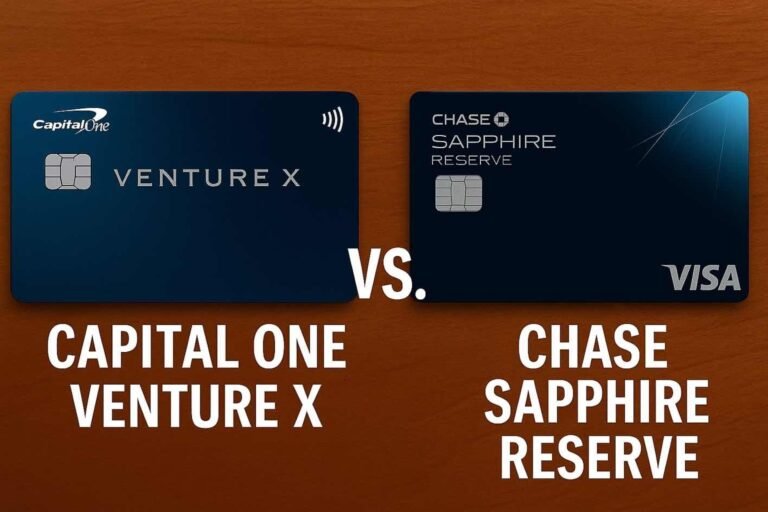Affiliate Disclosure: Travel with Plastic may earn a commission or referral bonus from some links on this site. These affiliate links help support our work and may influence the placement or promotion of certain products or services. However, our content is independently crafted to reflect honest opinions. Not all offers or products are included. There is no additional cost to users when they utilize our affiliate links.
When it comes to premium credit cards, the Capital One Venture X Rewards Credit Card and the Chase Sapphire Reserve are two formidable contenders. Both cards, highly regarded for their travel-focused rewards, offer robust benefits but do so with differing strategies. Let’s delve into how these two giants compare on various fronts and which might suit your travel lifestyle better.
Annual Fees and Credits
When deciding on a premium credit card, one of the first considerations is often the annual fee.
- Capital One Venture X: This card carries a $395 annual fee. However, it helps offset this with an annual $300 credit for travel booked through Capital One Travel, effectively lowering the overall cost if you frequently use their portal.
- Chase Sapphire Reserve: The Sapphire Reserve’s annual fee is $550. While steeper, this is balanced by a $300 yearly travel credit applicable for a broad range of travel expenses, including flights, hotels, and even rideshares. This credit is simple to utilize and covers a wide array of expenses right from the outset.
The differences in annual fee credits emphasize the need to consider how you plan to book travel and whether one provider’s booking experience works better for your plans.
Points Earning Potential
Both cards offer lucrative points-earning structures but cater to slightly different spending habits.
- Capital One Venture X: This card offers unlimited 2x miles on all purchases, making it an excellent choice for those who value simplicity in earning rewards. Additionally, 5x miles are awarded on flights booked through Capital One Travel, and 10x on hotels and rental cars booked through the same portal.
- Chase Sapphire Reserve: A more dynamic choice, the Sapphire Reserve offers 3x points on travel immediately after earning your $300 travel credit. It also provides 3x points on dining worldwide. For travel booked through Chase’s Ultimate Rewards portal, cardholders can earn 5x points on flights and 10x on hotels and car rentals.
This structure highlights the importance of deciding whether you prefer a straightforward earning rate or the potential for higher points on specific categories like dining and travel purchases.
Travel and Protection Benefits
Both cards provide a suite of travel protections and perks, appealing to the savvy traveler.
- Capital One Venture X: Offers up to $500,000 in travel accident insurance, reimburses trip cancellations, interruptions, and has no foreign transaction fees. Notably, it includes a Priority Pass membership for airport lounge access, featuring over 1,300 lounges worldwide.
- Chase Sapphire Reserve: Renowned for its exceptional travel protection benefits, cardholders enjoy trip cancellation/ interruption insurance, primary car rental insurance, and emergency evacuation and transportation, among others. The Sapphire Reserve also provides access to the Chase Sapphire Lounge by The Club and a Priority Pass membership.
These benefits are crucial for frequent travelers who value peace of mind while globe-trotting, but they also underscore the different scales and scopes of coverage each card offers.
Redemption Options
How you redeem your points can significantly enhance their value.
- Capital One Venture X: Cardholders can redeem miles for recent travel purchases, book new travel through Capital One Travel, or transfer miles to Capital One’s airline and hotel partners. Though Capital One’s partner list is smaller than some competitors, it includes valuable partners for international travel.
- Chase Sapphire Reserve: The real power of the Sapphire Reserve shines with its 1.5 cents per point for travel redemption through the Chase Ultimate Rewards portal. Additionally, points can be transferred to a wide array of airline and hotel partners, which includes some of the most illustrious names in travel.
The flexibility and increased value of point redemptions through Chase Ultimate Rewards make the Sapphire Reserve favorable for those who like to maximize their points’ value through strategic transfers and redemptions.
Conclusion
Ultimately, choosing between the Capital One Venture X and the Chase Sapphire Reserve depends on your travel habits and preferences. The Venture X might appeal more to those looking for a card with a lower annual fee and straightforward earning potential. In contrast, the Sapphire Reserve might attract travelers who are willing to pay a higher fee for extensive point redemption flexibility and robust travel protections. Carefully consider how each card’s benefits align with your travel and spending patterns to ensure you get the most value from your choice.

